Local Beijing Tours
Tour Tips
The Forbidden City 
Located in the center of Beijing, the Forbidden City (also named Palace Museum, Chinese Name: Gugong), regarded as a must-see spot for travelers, is a magnificent and awe-inspiring sight. For almost five centuries, it served as the home of 24 Emperors and their households, and the ceremonial and political center of the Chinese imperial government.
Notice: Closed on Monday every week.
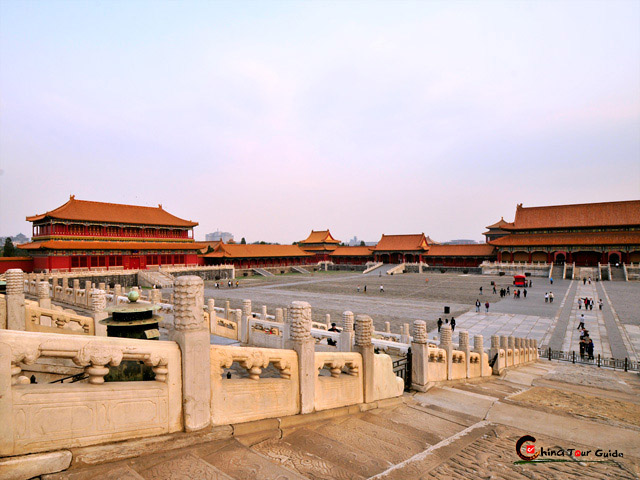 |
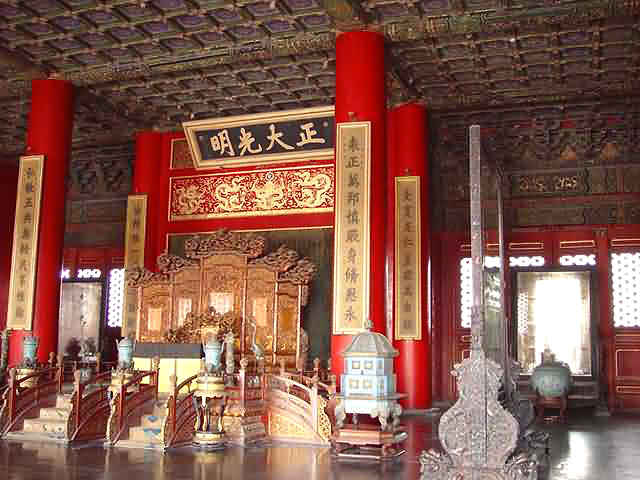 |
| In the Forbidden City, it is easy to get lost in a maze of courtyards, halls and passageways. | One of the many thrones room throughout the Forbidden City |
A poet of Tang Dynasty once wrote that: Without seeing the magnificence of the royal palace, one can never sense the dignity of the emperor. Indeed, with its massive scale and historical significance, the Forbidden City must invoke visitors' imaginations. Its clear lines, perfect proportions, and dramatic color scheme of vermilion walls, white marble terrace and staircases, and brilliant yellow-tiled roofs create one of the world's most beautiful architectural complexes. Serving as the seat of imperial power during the Ming and Qing Dynasties, the Forbidden City houses numerous rare treasures and curiosities. The site has been recognized worldwide for its monumental importance and was listed by UNESCO as a World Cultural Heritage Site in 1987.
Facts About the Forbidden City
| Building Period: | 14 Years (1406 - 1420) | Building Reign: | Emperor Yonglu of Ming Dynasty |
| Total Area: | 72 hectares | Construction Area: | 15.5 hectares |
| Households: | 14 Emperors of Ming & 10 Emperors of Qing Dynasty | Construction Style: | Symmetrical arrangement |
| Total Room: | 8707 Rooms (9999.5 Rooms in myth) |
The Moat: | Tongzi River, 52 meter wide |
| Southern Entrance: | Meridian Gate (Wu Men) | Northern Entrance: | Gate of Divine Prowess (Shenwumen) |
| Eastern Entrance: | East Flowery Gate (Donghuamen) | Western Entrance: | West Flowery Gate (Xihuamen) |
| Surrounding by: | A Rectangular Wall, 9.9 meter high, 3,400 meter long | Main Colors: | Red, Yellow and Golden |
Map of the Forbidden City (click to enlarge)
The Forbidden City (Gugong) is divided into two parts. The southern section, or the Outer Court, is home to the official buildings where the emperor carried out national affairs and publicly ruled. The northern section, or the Inner Court, was where he lived with his royal family. It was built along a meridian line. From the Dragon Throne, an axis can be drawn directly south through the many gates, right through to Qianmen and on. Taking in the whole site requires at least 3 hours, and a comfortable pair of shoes. For more detailed Forbidden City traveling spots, please see Must-see part.
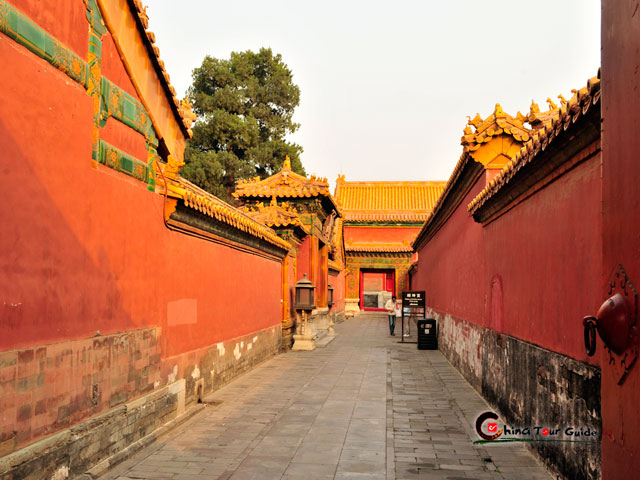 |
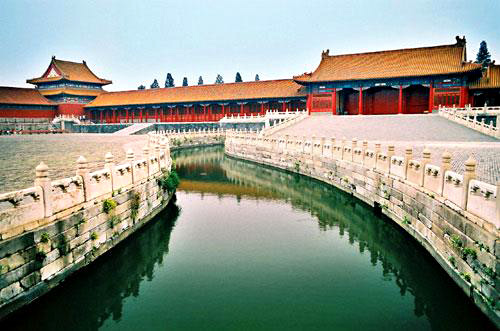 |
| Red bricks and yellow tiles set the tone of the Forbidden City, presenting the supremacy of Chinese royal family. | Go across the Golden Stream Bridge you will arrive at the outer court. |
Construction of the Forbidden City
Among top Five Grand Palaces of World (the Buckingham Palace of United Kingdoms, the Kremlin of Russia, the White House of America, the Versailles Palace of France, the Forbidden City of China), the Forbidden City ranks the No.1 palace all over the world for its greatest construction.
The palace complex exemplifies traditional Chinese palatial architecture and has been used as a model that has had significant influence on cultural and architectural developments throughout East Asia. It is alleged that as many as 1,000,000 workers and 100,000 artisans participated in the construction of this imperial palace. The massive project ordered by Emperor Yongle of the Ming Dynasty was undertaken in 1406 and took 14 years to complete. The stone needed was quarried from Fangshan, a suburb of Beijing. It is believed that a well was dug every fifty meters (164 feet) along the road so that in the winter water could be easily poured onto it. This would then freeze and huge stones were slid across it to make transporting them to the city easier. The huge amounts of timber and other materials needed were hauled in from faraway provinces. The design of the Forbidden City reflects the impressive skill of those who built it. For example, the city wall was built narrowing from bottom to top in a way that totally frustrates attempts to climb it. The bricks were made from white lime and glutinous rice while the cement was made from glutinous rice and egg whites. These incredible materials make the wall extraordinarily strong.
History of the Forbidden City
For almost five centuries, twenty-four emperors, "sons of Heaven" of the Ming and Qing dynasties ruled Celestial Empire from within the vermilion walls of the Forbidden City over a span of 491 years (between 1421 and 1911). The construction of the Forbidden City started from 1406, and lasted about fourteen years during the reign of Emperor Yongle who was the third emperor of Ming dynasty. After its completion, Emperor Yongle moved the capital of Ming dynasty from Nanjing to Beijing. Since then, the Forbidden City had served as three functions in Ming and Qing dynasties, such as the nation's ruling centre, the symbol of imperial power (or authority), and the living quarters for the emperors, empress, imperial concubines, princes and emperor's grandsons. In total, fourteen emperors of Ming dynasty and ten emperors of Qing dynasty had lived here.
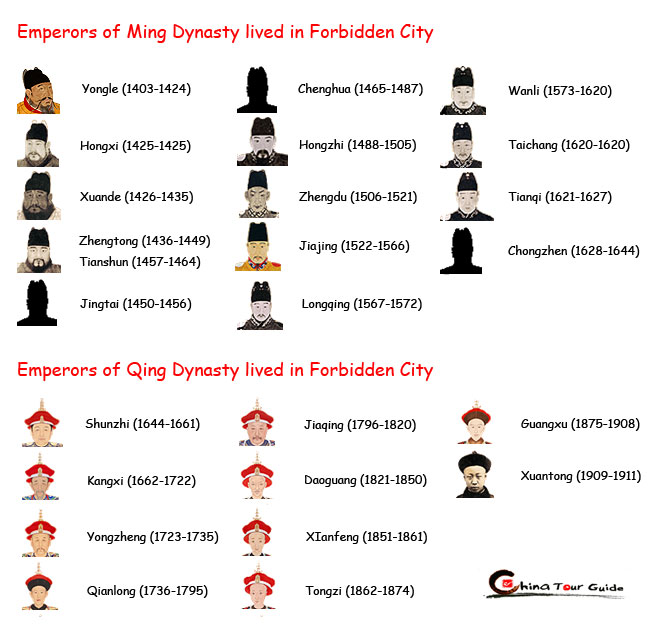
The Qing dynasty collapsed in 1911, while the last emperor of Qing dynasty - Emperor Aisin Gioro Puyi still lived in the inner court of the Forbidden City under an agreement with the new Republic of China, and the outer court was given over to public use. In 1924, Puyi was evicted after a coup. The Palace Museum was then established in the Forbidden City in 1925. Unfortunately, in 1933, the Japanese invasion of China forced the evacuation of the national treasures in the Forbidden City. Part of the collection was returned at the end of World War II, but the other part was evacuated to Taiwan in 1947. After the establishment of the People's Republic of China in 1949, some damage was done to the Forbidden City as the country was swept up in revolutionary zeal. After the Forbidden City was listed as a World Cultural Heritage Site in 1987 by UNESCO, it experienced sixteen year restoration and repair project. Nowadays, the Forbidden City, or the Palace Museum is open to public tourists from home and abroad.
Interesting Forbidden Stories of the Forbidden City
As the center of imperial power for two dynasties, the Forbidden City always forbade common people to close, and hid lots of historical mysteries from public. Once they were live, the history had no ends.
1. Mysterious Fires and the Emperor Yongle of Ming Dynasty
In history, after the third emperor of Ming dynasty - Emperor Yongle usurped his throne from his nephew Emperor Jianwen, who later mysteriously disappeared. Later Emperor Yongle shifted the capital from Nanjing to Beijing in 1420. In just less then 100 days after the completion of the Forbidden City, the three major halls were burned down by a mysterious fire. Emperor Yongle believed that this might be a curse of his usurping the throne illegally. His deed might have disobeyed the willingness of the God. So he dared not to rebuild the three major halls during his reign. It was not until 1439 in the Emperor Yingzong period that the three major halls were reconstructed.
2.The Kangxi Emperor Throw off Obio's Regency
The Kangxi Emperor (r. 1662-1722), Aisin Gioro Xuanye, ascended to the throne at eight, an age too young to make political decisions. His father, the Shunzhi Emperor (r. 1644-1661) nominated on his death bed four Manchu mandarins as "Executive Ministers" (fuzheng dachen) to assist his eight-year-old son in governing the country. Among those ministers, Oboi (?-1669), a most decorated military commander, rose to power and dominated the government. He was a serious menace to the imperial power of the Kangxi Emperor. |
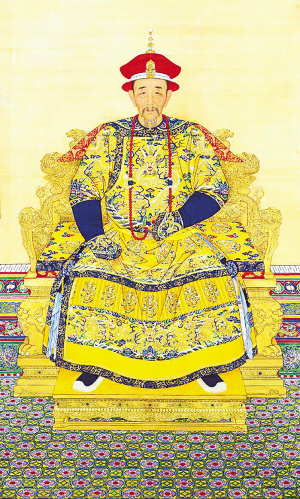 Kangxi Emperor |
| The teenage Kangxi Emperor secretly made a plan to eliminate Oboi. On the surface, he indulged himself in wrestling to relax Obio’s vigilance. Actually, those wrestlers were carefully selected Manchu bodyguards. One day, responding to the call of the Kangxi Emperor, Oboi was arrested secretly by these bodyguards by a charge of carrying a weapon to assassinate the emperor. Then the astute sixteen-year-old Kangxi Emperor displayed skill in dispatching Oboi and his faction without causing political upheaval. |
3. Zhen Concubine and Zhen Concubine Well
| Zhen Concubine was a beloved concubine of Qing Emperor Guangxu, she was smart and beautiful, fully supporting Guangxu’s political revolution, while being hated by Dowager Empress Cixi.In 1898, Empress Dowager Cixi once again obtained the political power from Emperor Guangxu, and arrested Zhen Concubine within a small courtyard in order to avoid her meet with Emperor Guangxu. She was left alone with no one to talk with as no one dares to do so. | 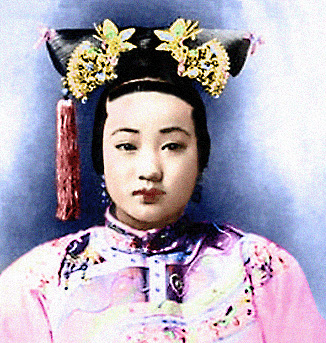 Zhenfei Concubine |
| In year 1900, when the allied forces attacked Beijing, Empress Dowager Cixi had ordered to kill Zhen Concubine before she left Forbidden City with Emperor Guangxu. So this poor Zhen Concubine was pushed into the well. Later, the well was named as Zhen Concubine's Well in order to commemorate her. You can visit it now at the northeast of the palace museum. |
4.The Last Emperor - Puyi
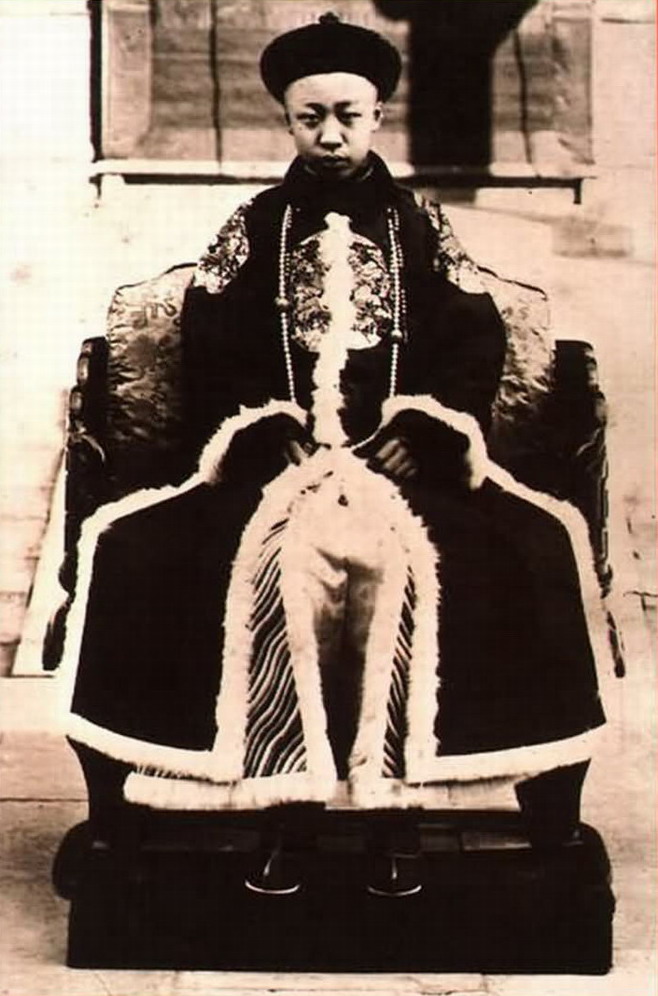 Aisin Gioro Puyi (1906-1967) |
Puyi is the last emperor of Qing Dynasty, also the last one in Chinese history. He is a legendary figure, and experienced many vicissitudes in his life. He was put to the throne at the age of three; he was a puppet of the Japanese government; he was taken prison; he was turned into a common citizen by the Chinese Communist Party. He had five wives in his whole life. Among the 12 emperors of Qing Dynasty, Puyi had the following features: Puyi was the last emperor of Qing Dynasty; He was the youngest emperor when he ascended the throne; He had the shortest period of standing as an emperor; He had no posthumous title owned by an emperor; He had no royal tomb. |
| There was an ironic story that at the grand ceremony of Puyi becoming the emperor, he was too young and too scared to keep calm. He kept crying during the ceremony. His father was just beside him. His father said, “Don’t cry! Don’t Cry! It will be finished soon! It will be finished soon!” Many people comment that it is the ominous word that sent the Qing Dynasty overthrown three years later. |
Old Pictures of the Forbidden City
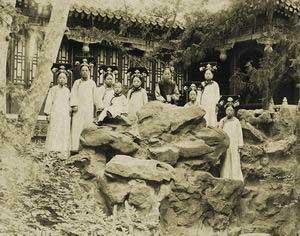 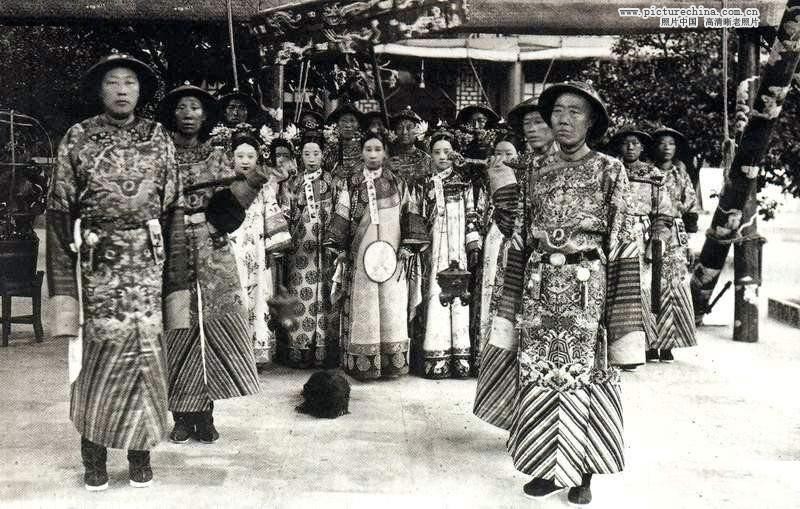 |
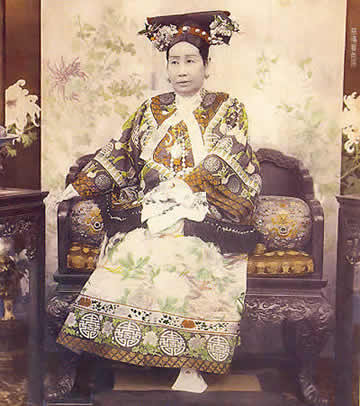 |
 |
| Concubines and Eunuchs of Qing Dynasty |
Empress Dowager Cixi (1835 - 1908) |
Must-see of the Forbidden City
- Meridian Gate (Wumen)
- Hall of Supreme Harmony (Taihedian)
- Hall of Central Harmony (Zhonghedian)
- Hall of Preserved Harmony (Baohedian)
- Palace of Heavenly Purity (Qianqinggong)
- Palace of Union and Peace (Jiaotaidian)
- Palace of Earthly Tranquility (Kunninggong)
- Palace of Earthly Tranquility (Kunninggong)
You can see detailed location of every spots in the map of the Forbidden City (click to enlarge).
| The Meridian Gate (Wumen Gate) is the southern gate of the Forbidden City, having five arches. The three central arches are close together, the two side arches are apart from the three ones. Above the arches are a series of buildings, and during the Ming and Qing dynasties, the emperors reviewed royal troops from the central palace. Also the Meridian gate was the place where the Emperor announced the new lunar calendar on the winter solstice. After entering the Meridian Gate and across the Golden Stream Bridge, the Outer Court will be reached. | 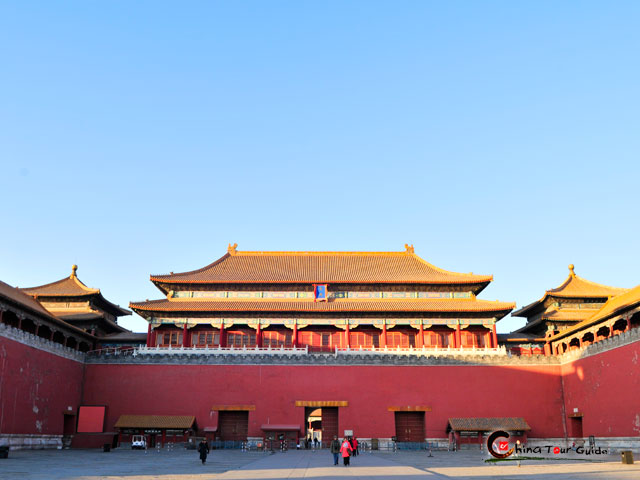 |
| The Hall of Supreme Harmony, also named Golden Carriage Palace, regarded as the highest structure in Beijing during the Ming and Qing dynasties. With the most rooms, the most spacious hall and the highest rooftop, it was ranked as the grandest hall in China, used to hold grand ceremonies, like a new emperor ascended the throne or the emperor appointed a new empress. As a symbol of imperial power, this grand hall presented the distinctive designs and the overwhelming expertise of the ancient architects. | 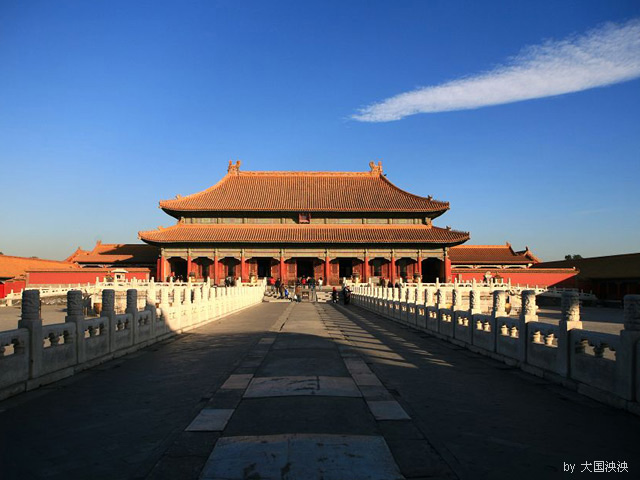 |
| The Hall of Central Harmony (Zhonghedian) was one of main halls of the Outer Court, sitting between the Hall of Supreme Harmony and the Hall of Preserved Harmony on the central axis of the Forbidden City. Of the three halls, the Hall of Central Harmony is the smallest, occupying a total area of 580 square meters, the hall is a square structure built like a pavilion, was used to serve as a place for rest for the emperor when he was on his way to hold ceremonies in the Hall of Supreme Harmony, and receiving homage from royal officials. | 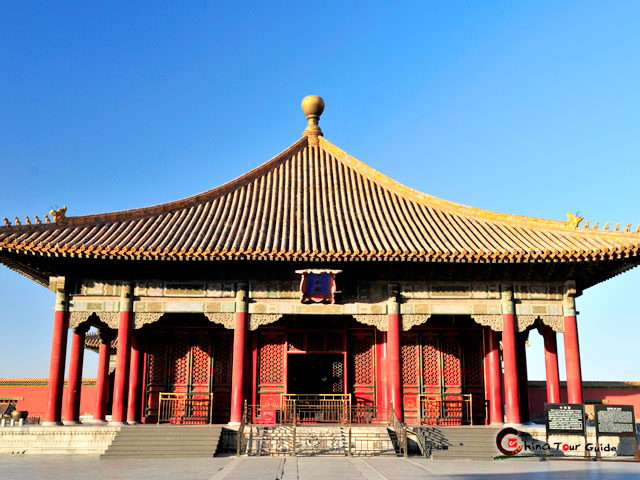 |
| The Hall of Preserved Harmony is located at the northern end of the three-tier marble terrace. It is similar in style but smaller than the Hall of Supreme Harmony. It was built in 1420, rebuilt in 1625 and renovated in 1765. During the Qing dynasty, it was usual for imperial banquets to be held here, such as banquets to celebrate a princess's marriage or to entertain high officials, the bridegroom and his father together with their relatives who served the imperial government. | 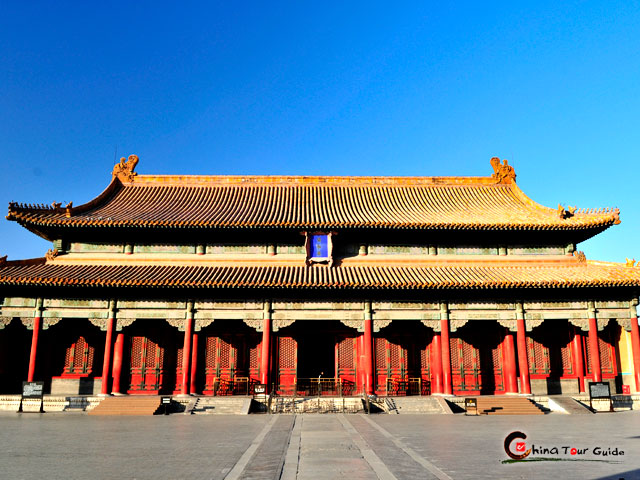 |
| The Palace of Heavenly Purity (Qianqinggong or Palace of Celestial Purity), the largest palace in the Inner Court of Forbidden City, is a smaller version of the Hall of Supreme Harmony, served as the sleeping quarters of the emperors. Since Emperor Yongzheng of Qing Dynasty, The Palace of Heavenly Purity became the Emperor's audience hall, where he held court, received ministers and emissaries, and held banquets. |  |
| Palace of Union and Peace (Jiaotaidian), also named the Hall of Celestial and Terrestrial Union, was established in the reign of Jiajing (1522-1566) of the Ming Dynasty (1368-1644), and was restored twice in 1655 and in 1669. It is square in shape with a pyramidal roof. Stored here are the twenty-five Imperial Seals of the Qing Dynasty, as well as other ceremonial items, including the clocks that set the official time in the palace (first a water clock, later a mechanical clock), both still displayed in the hall. | 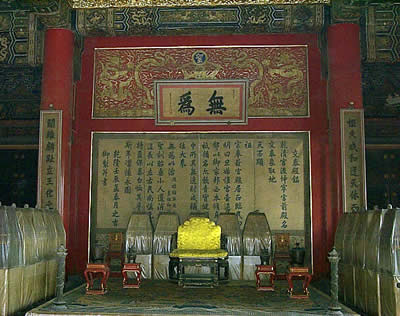 |
| The Palace of Earthly Tranquility (Palace of Terrestrial Tranquility or Kunninggong) is the last of the three main palaces in the Inner Court of the Forbidden City. Twenty-two meters high, the Palace of Earthly Tranquility has a double-eaved roof with side buildings just like the Palace of Heavenly Purity but smaller. The palace was where the empress lived in the Ming Dynasty (1368-1644). However, after reconstruction in the Qing Dynasty (1644-1911), it served as the nuptial chamber of the emperor and empress and the altar for worshipping the deities of Shamanism. | 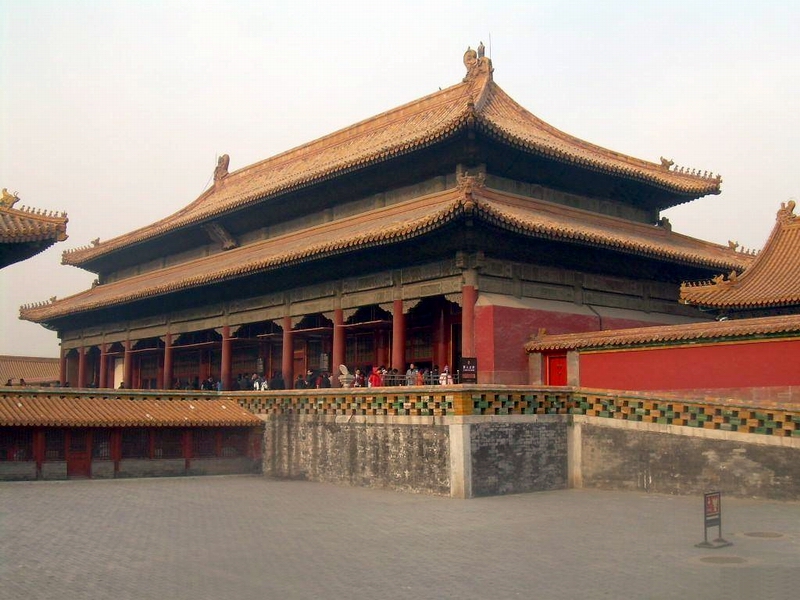 |
| The Gate of Divine Might or Gate of Divine Prowess (Shenwumen) is the northern gate of the Forbidden City. It faces Jingshan Park. A tablet above the doorway reads "The Palace Museum" in Chinese. Originally this gate was called Xuanwumen, while when the Kangxi Emperor ascended to the throne, his birth name was Xuanye, so this gate had to change another name to avoid matching his name. The new character Shen means Divine in Chinese. | 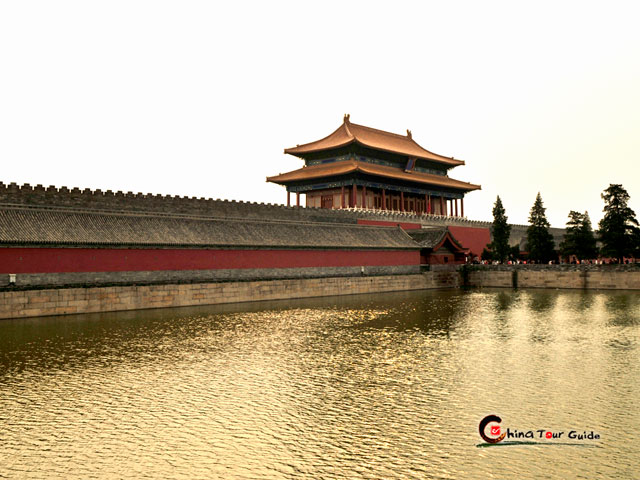 |
Regular Travel Route of Forbidden City
Most travelers enter the Forbidden City from the Tian'anmen Gate, and have a shortcut by visiting along the central axis. Firstly enter the Meridian Gate, and go across the Golden Stream Bridge you will arrive at the outer court. Then passing the Hall of Supreme Harmony (Taihedian), the Hall of Central Harmony (Zhonghedian) and the Hall of Preserving Harmony (Baohedian), later out from the Hall of the Preserving Harmony, you will notice a huge block of marble carved with cloud and dragon designs. Go straight, and you will see another gate, called Gate of Heavenly Peace (Qianqingmen). This is the main gateway to the inner living court. The inner court is composed of the three main structures at the rear of the Forbidden City, namely the Palace of Heavenly Peace (Qianqinggong), the Palace of Union and Peace (Jiaotaidian) and the Palace of Terrestrial Tranquility (Kunninggong). At last, you can leave the Forbidden City from the Gate of Divine Might after visiting the Imperial Garden. Totally, it takes more than one hour to finish all spots along the central axis of the Forbidden City.
Travel Tips
| Admission | Open Hours |
| April 1st – October 31st: CNY 60 | April 1st - October 31st : 8:30 to 17:00 Last entry: 16:10 Last tickets are sold at 16:00 |
| November 1st – March 31st: CNY 40 | November 1st - March 31st : 8:30 to 16:30 Last entry: 15:40 Last tickets are sold at 15:30 |
Transportation of the Forbidden City
By Bus:
1. To the Gate of Divine Prowess (Shenwu men), take bus No. 101, 103, 109, 111, 124, 810, 685, 814, 846, or Zhuan 1 (a suttle bus traveling between Qianmen and The Palace Museum), to "Gugong".
To the Meridian Gate(Wu men), take bus No.1, 10, 120, 126, 2, 20, 37, 4, 52, 59, 728, 802, Olympic line.
2. or Te 1, to "Tian'an Men East" (Tian'an men dong). Or take bus No. 1, 10, 22, 37, 4, 5, 52, 728, 802, or Te1, to "Tian'an men West" (Tian'an men xi).
By Subway:
Take Line 1 to Tian'an men East or "Tian'an men West" (Tian'an men xi).
Beijing Tours With Forbidden City
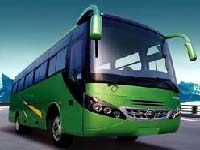
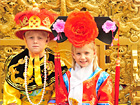

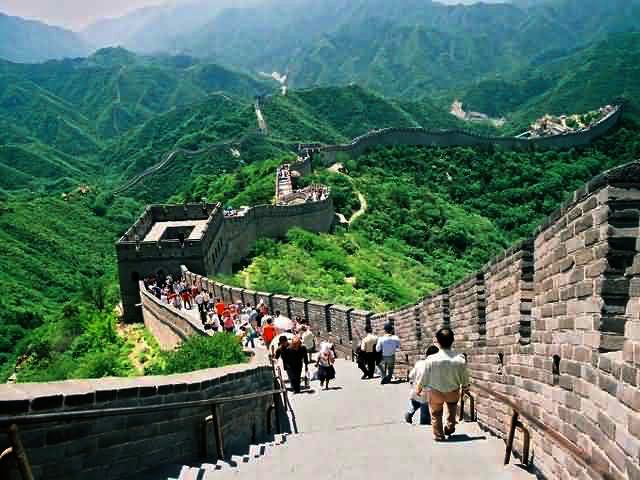
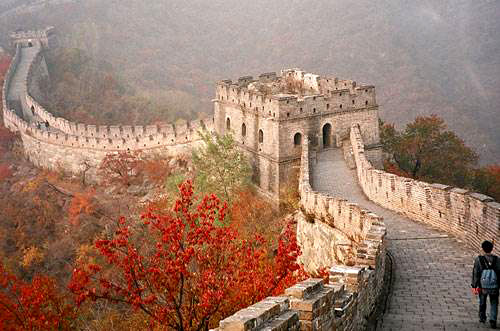
Select Other Favorite Attractions
| Recommended China Tours with Beijing | ||||||
|
||||||
|
||||||
|
||||||
|
||||||
|
||||||
|
||||||
Guide for China tour, offers most value & amazing experience. In China, you can rely on us
Copyright © 2001 - 2025. All Rights Reserved to ChinaTourGuide.Com
Hotel Guangzhou | Guizhou Tours | Hong Kong Hotels | 香港酒店 | 广州酒店 | 广州会议酒店 | Indochina Tour
Guide for China tours, offers most value & amazing experience. Chinatourguide.com. Your reliable China tour agency.



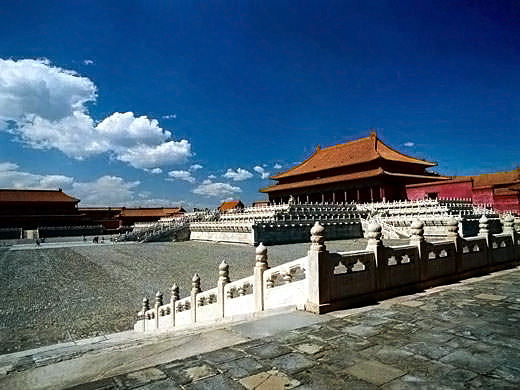
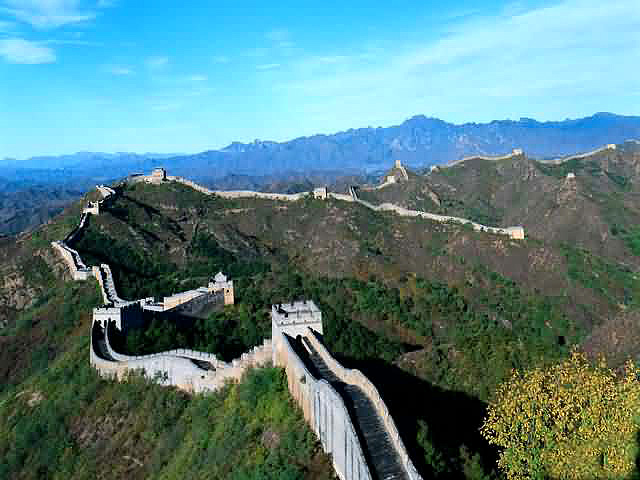

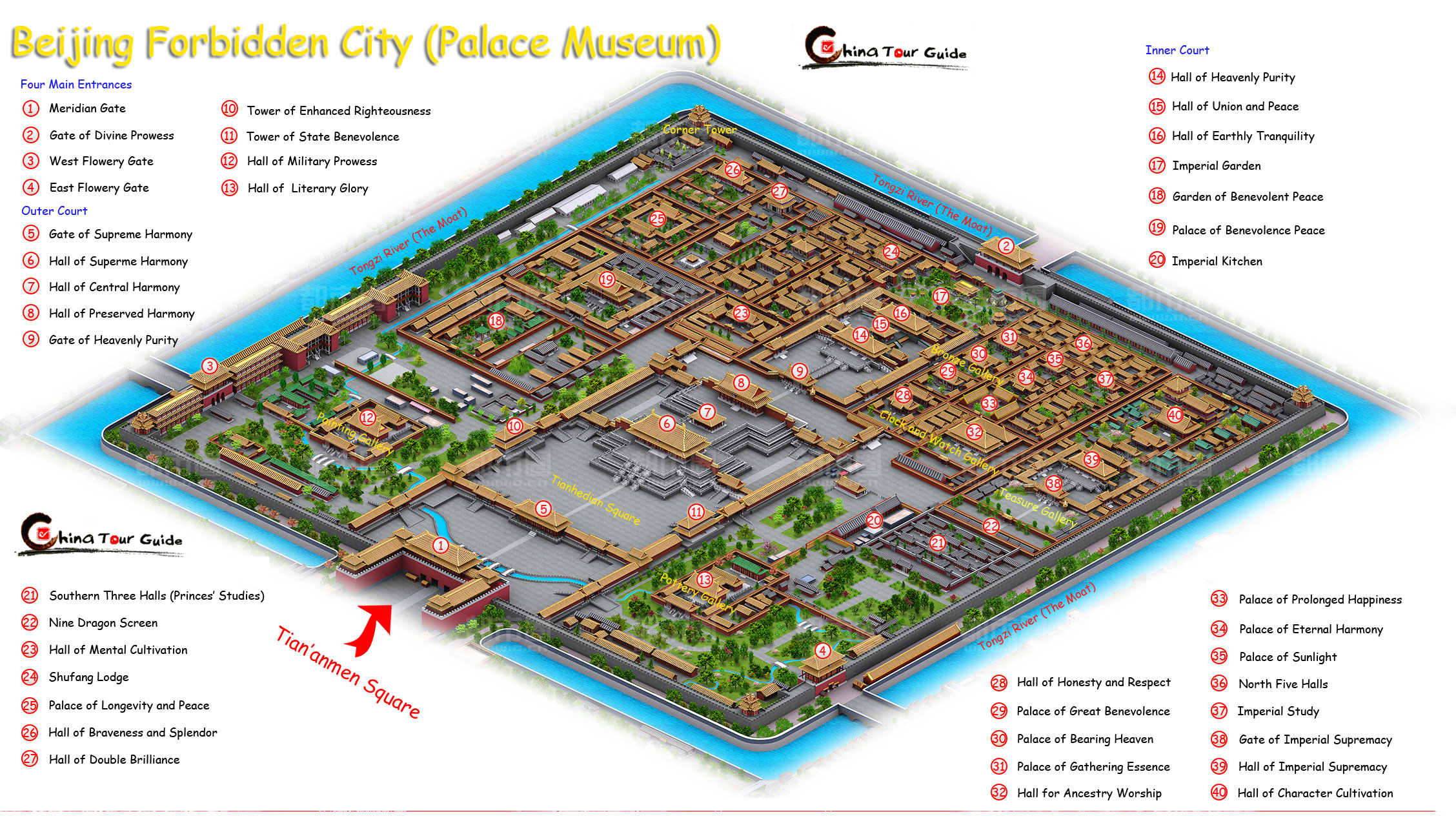
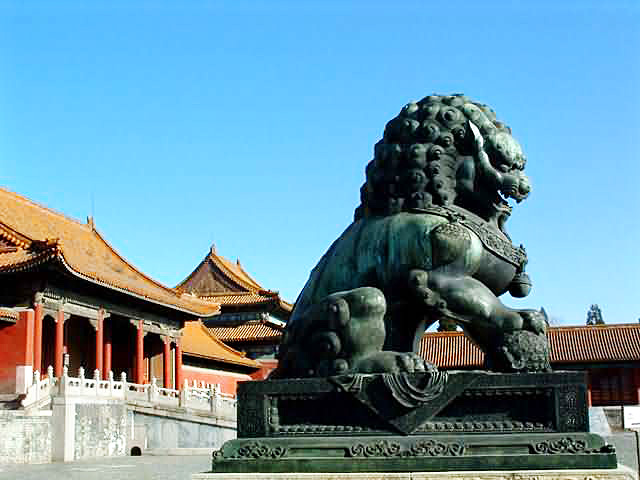
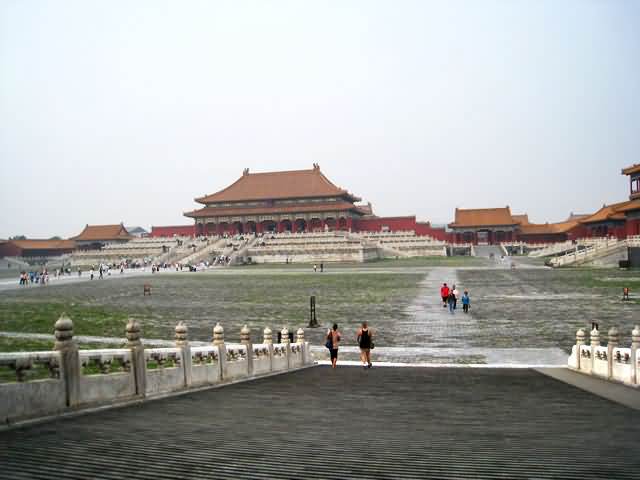

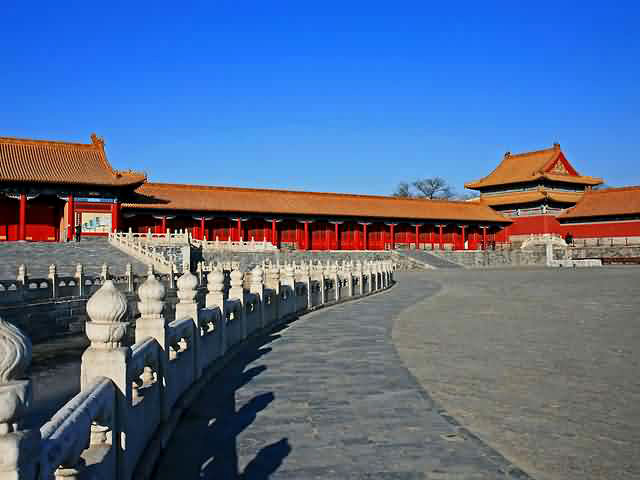
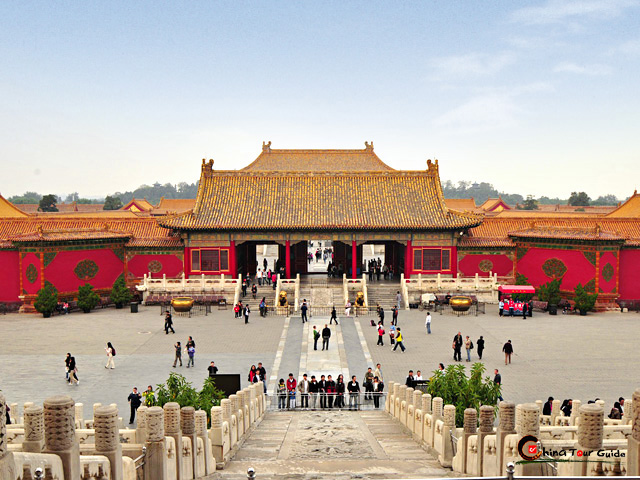
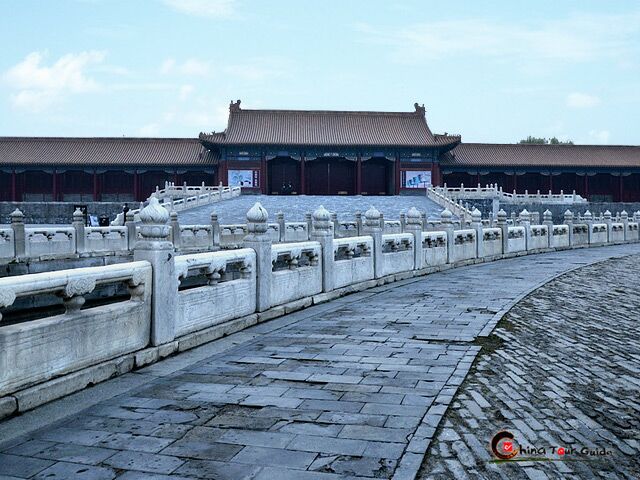
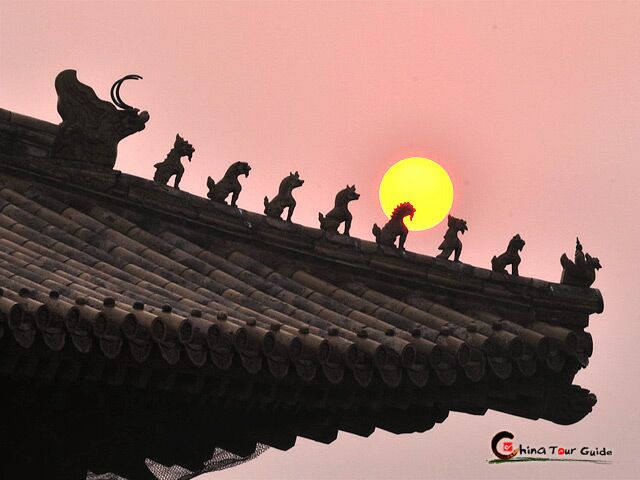

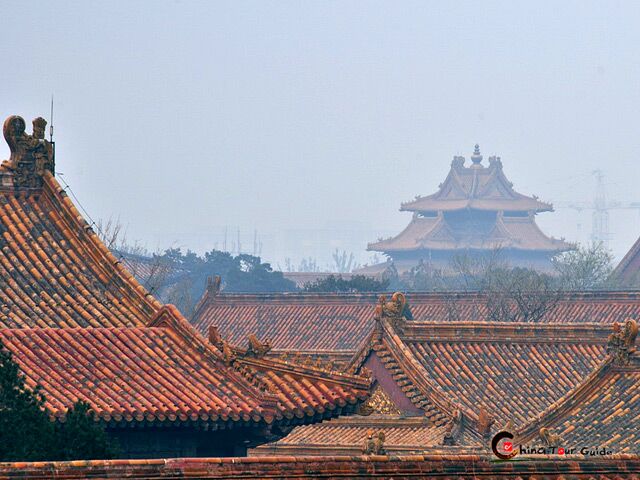

 More
China Tours
More
China Tours